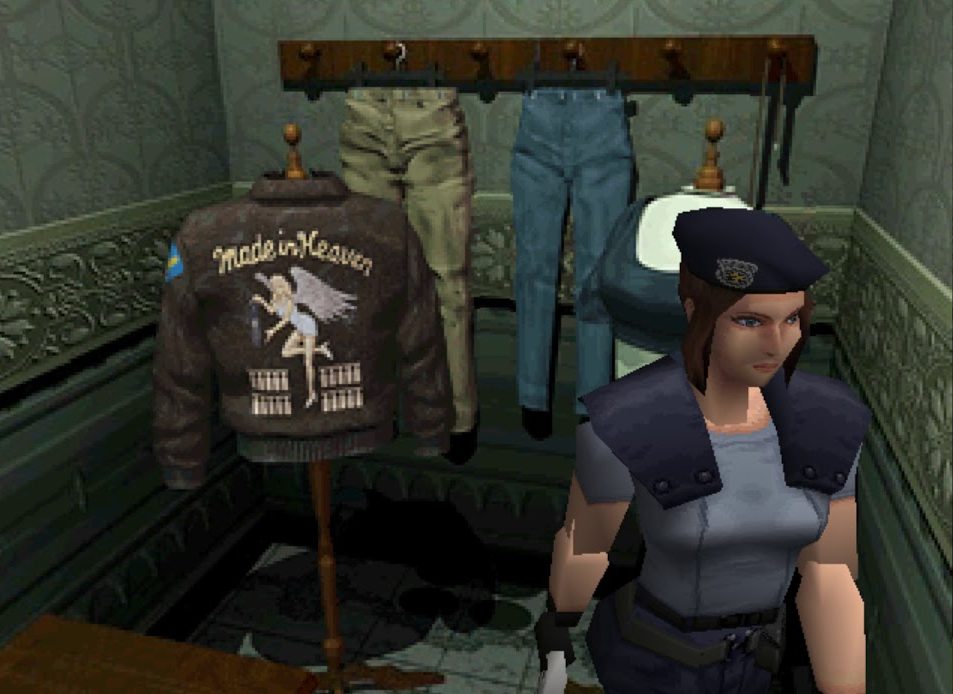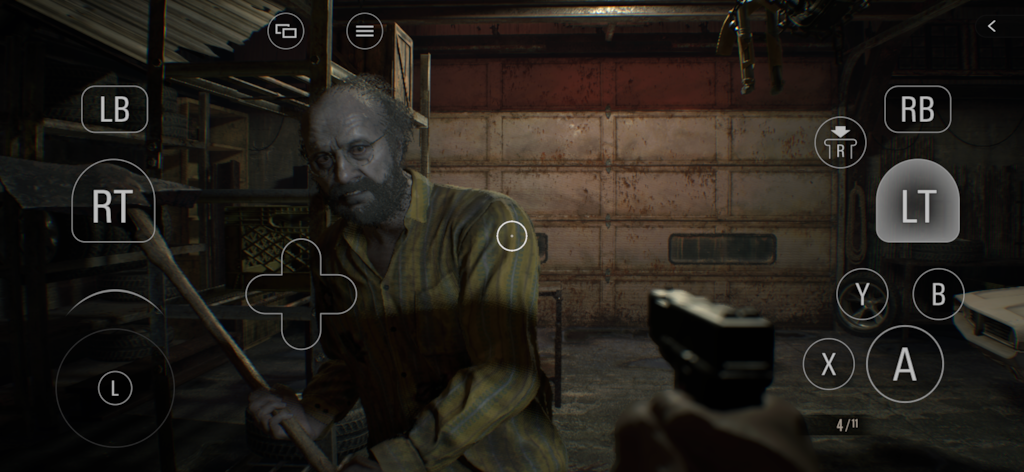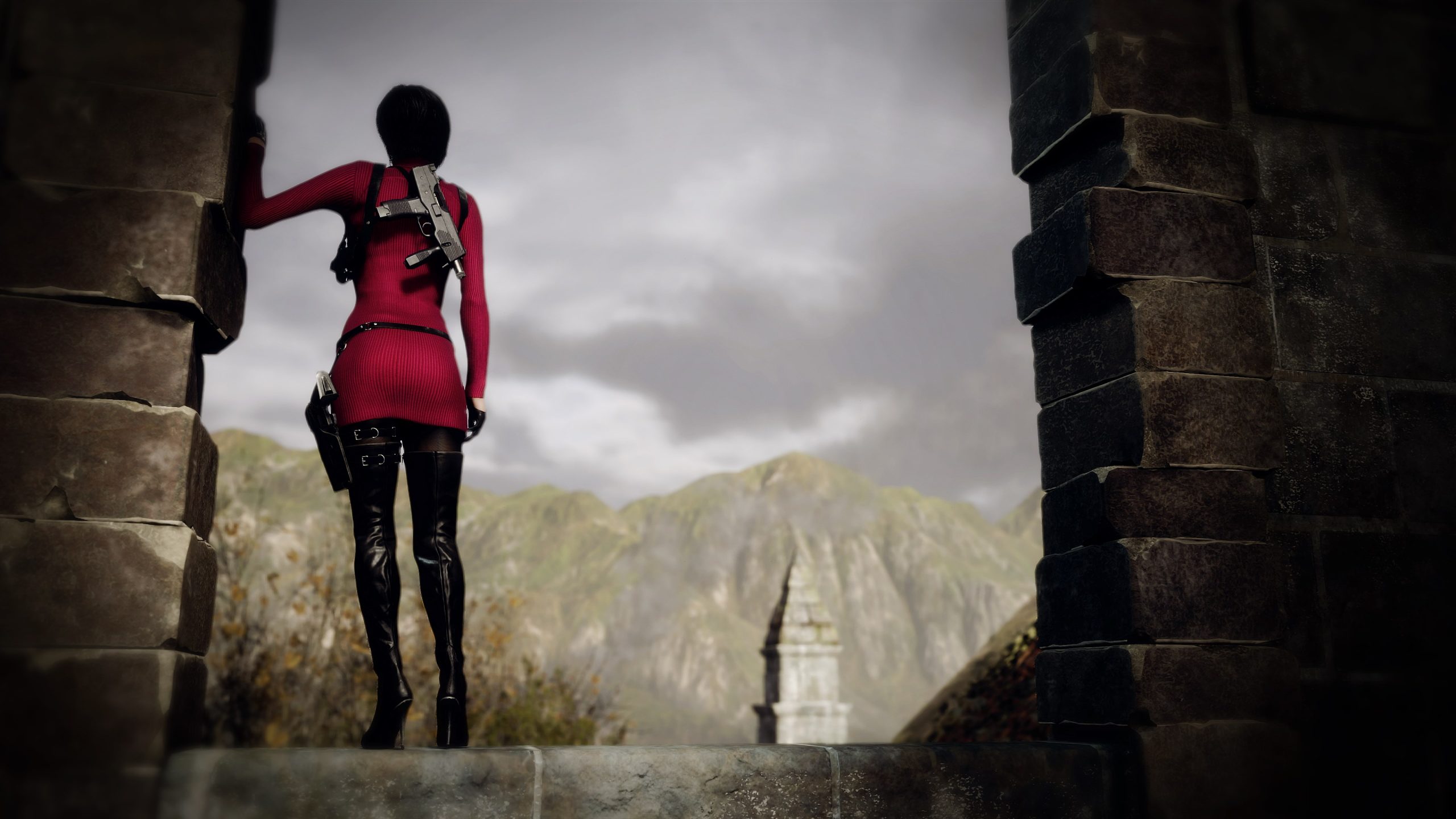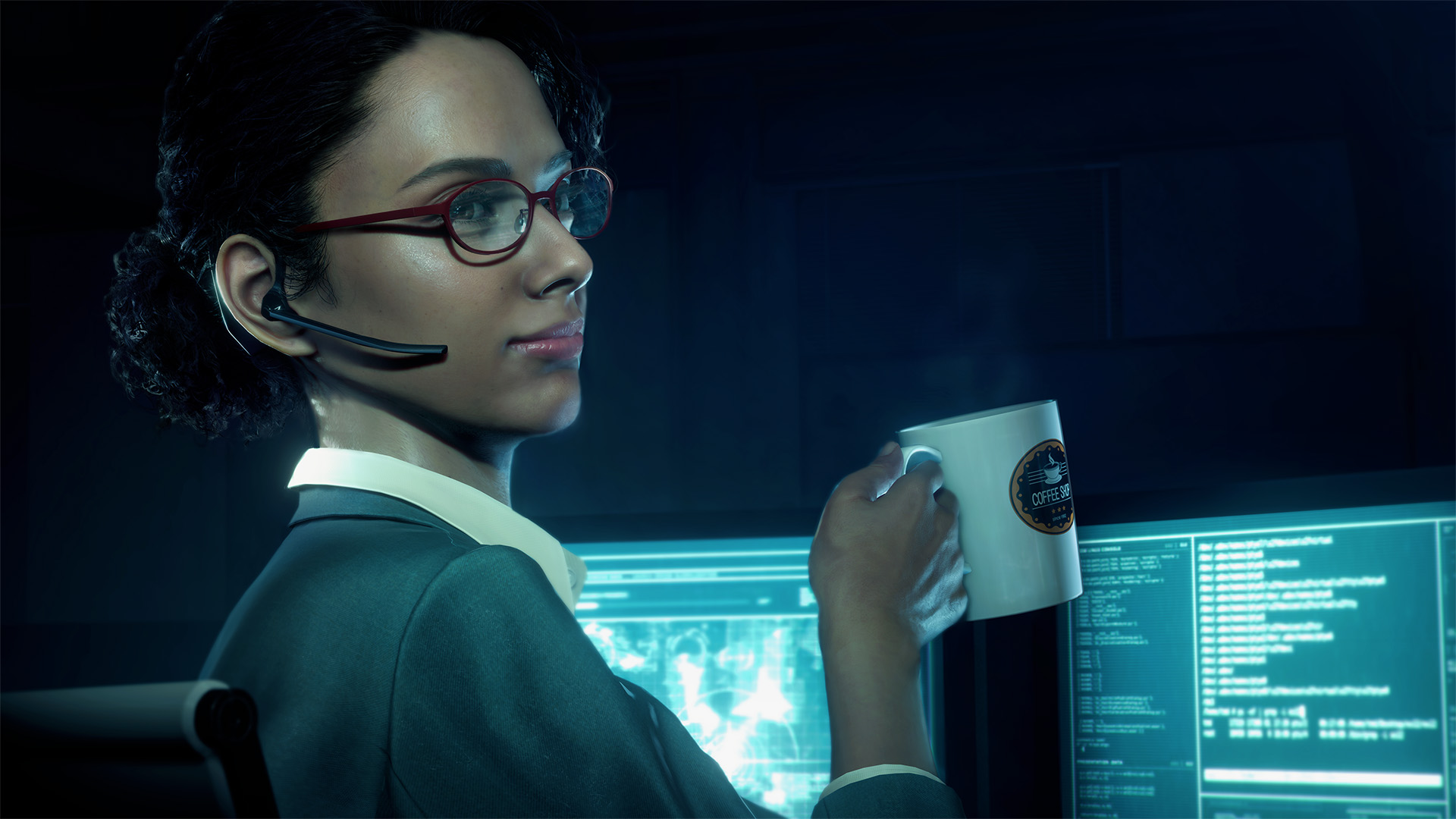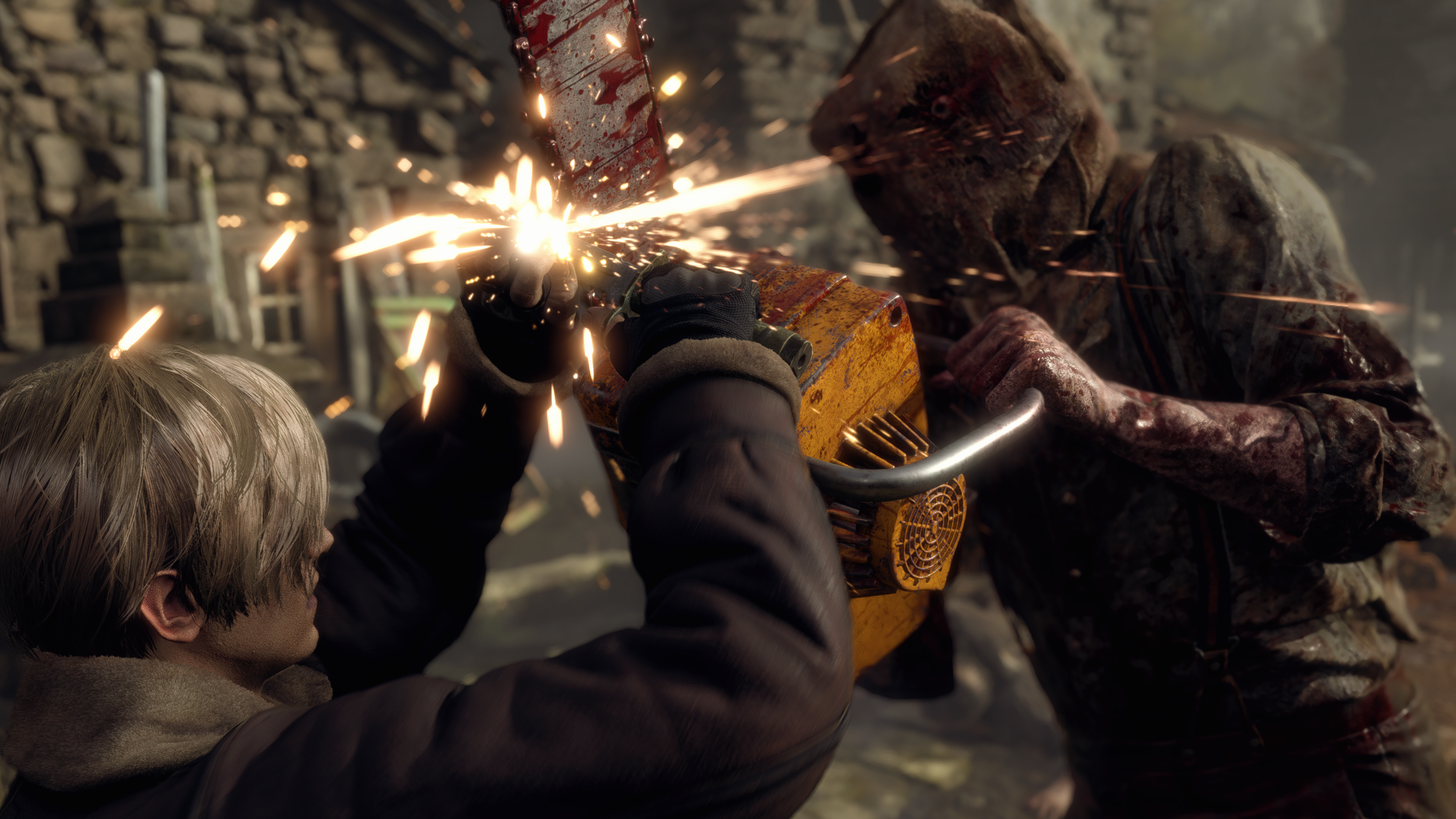This entry us a translation of a blog posted on Capcom Japan. You can find the blog here.
Okay everyone, global shipments have exceed 3 million! Is everyone enjoying Resident Evil 7: Biohazard, the current best-selling game in the U.S.?
Since its release on January 26, 2017,
“It’s very scary.”
“This is fear of the highest standard.”
“I can no longer go to the toilet at night.”
and other types of feedback have been heard. All players, including these authors, continue to fall into the depths of fear through this game. “This is the legitimate successor to the original Resident Evil” is also an opinion we hear often.
However, by comparing RE7 to the original Resident Evil, which was released 20 years ago, it is clear there are large differences in their visual appearance and gameplay systems due to hardware limitations from that era.

Screenshots for the original Resident Evil and Resident Evil 7.
The difference between fixed-view camera angles and first-person view also leave very different impressions.
That said, if you play RE7, you might experience similar sensations and impressions to the original Resident Evil, regardless of how different the graphics and gameplay are. Everyone is experiencing the sensation of fear described in Capcom Legends Vol. 2: “Resident Evil: Fear of Corners…”.
Just what sort of secrets exist within?
In order to pursue these mysteries, this edition of “Capcom Legend” will speak with Resident Evil 7 Director Koshi Nakanishi, as well as invite Director Yasuhiro Anpo, who was involved in development since the original Resident Evil. We will ask them about the Resident Evil series and its essence of fear.
What are the genes of Resident Evil? How does RE7 carry this onward?
This is a very long interview that was done across 4 sessions, but each session is packed full of exciting information! Please have a read!!

FROM THE ORIGINAL RESIDENT EVIL TO RE7
Director Anpo and Director Nakanishi, you have both have come today because we want to ask questions about the fear in Resident Evil. Both of you have been involved deeply with the Resident Evil series, and for Anpo-san in particular, you have been involved since the original Resident Evil. Regarding RE1, there are many urban legend-like rumors out there, but is it true that it originally started as a zombie game with hand-to-hand melee combat?
Anpo: No. I joined Capcom around the time of the original Resident Evil, and directly after its concept was planned. From an early stage, it was a game that involved firearm combat.

Screenshot of Resident Evil showing how firearms are used to fight zombies.
Ammunition is limited, and managing this limitation is difficult.
So that really is just an urban legend.
Nakanishi: Yeah, that’s what it is. (laughs) Also, there was talk about how the game’s flow came from “Sweet Home,” right?
Anpo: When I first joined the team, I was instructed to play Sweet Home for NES. I was told to learn about horror games in which mysteries are solved by using items, and that “we were making a 3D version of this game with zombies as the theme.”
Really? Was this something the Director asked you to do?

“Sweet Home,” a Famicom adventure game released in 1989.
Item capacity is limited and doors serve as points.
There are many elements in this popular adventure game that Resident Evil ended up carrying forward.
Anpo: Yes. However, this was actually a request I received from department head of even higher seniority. The department head requested us to make a game like “Sweet Home” using the newest technology.
Nakanishi: If we were to use Capcom’s present day technology, we could probably make “Sweet Home HD.” (laughs)
What was the atmosphere of development like back then?
Anpo: I had just joined the company, yet I couldn’t help but feel happy to be making a game; whenever possible, the three new hires would be at the company and make games on their own. Afterwards, I heard from Takeuchi-san (Jun Takeuchi, the Executive Producer for Resident Evil 7) that at that time, Capcom did not have high expectations for the game that would be called “Resident Evil,” and thus the team atmosphere was a bit like that of an independent team that went rogue. However, at that time I had absolutely no idea that was what was going on. (laughs)
An independent team like the S.T.A.R.S.? (laughs)
Anpo: Also, there was someone in the staff known as the “legendary programmer.” The “legendary” part referred to the person’s “loud voice that could resonate throughout the room.”
(laughs)
Anpo: Since that time, the RE Team has often discussed the direction the game should take. But his voice could be heard throughout the entire room, so senior employees (senpai) and other developments would get angry and say “How annoying!” However, the Director objected to changing things around, believing it strange to stop the passionate discussions that took place. Eventually, talking was okay so long as it was discussion about the game.
Nakanishi: The tradition of the “Resident Evil team liking discourse” probably continues on to this day. In the RE7 development team, there are 3 people with loud voices, including myself. We are often discussing games in voices so loud they reach the corners of the room. (laughs)
This is an episode in which your passion for your job could be communicated. (laughs) By the way, was the idea of having the door loading sequences, now a visual staple of Resident Evil, something that was decided at the beginning?
Anpo: This was also decided upon at the beginning.
Nakanishi: Was the changing of the fixed camera angles also decided at the beginning?
Anpo: No, at the beginning, we had wanted to use full polygons for the backgrounds, but given the specs we had to work with, it was impossible to have a certain number of zombies displayed at a high quality, so this is why we went with changing backgrounds.
I see.

When going into a room (when loading), the doors appear large on the screen.
This became a visual item of Resident Evil.
Director Nakanishi, what are your memories regarding the original Resident Evil?
Nakanishi: I worked at a different game company at that time, and I was a first year new employee around that time. I first experienced RE when I saw a copy of Resident Evil that might senior bought. I knew nothing about the game until this point, but when I tried it, my first impressions were, “Huh, WHAT is this? This is so scary!!” I bought the game right away. At that time, I was developing on the PlayStation, so I felt that it was fresh for the PlayStation being able to run this kind of scary game.

Screenshot for the original Resident Evil.
This is a horror game that used a low number of “3D polygons” for the time.
Nakanishi: I played through RE1, RE2 and CODE: Veronica in realtime. Regarding RE1, unlike the present day in which we have access to the internet, playing games involved a lot of exploring. My roommate played through the game, wondering out loud what to do. The game itself was also a hit that many were talking about.
Regarding how Capcom operated at the time, week after week there would be things that they would order to be added into the game, and that this did not decrease, nor could they establish a cut off. It is unbelievable how word about this can spread.
Nakanishi: Also, we developed Resident Evil 7 while taking into account the impact of the first game.
Huh, what does that mean exactly?

The original Resident Evil steadily became a hit.
What are the elements of this game’s creation that were used in RE7?
ANALYZING THE FEAR IN THE ORIGINAL RESIDENT EVIL
Nakanishi: The fear one experienced in the original Resident Evil may be rooted in the “player having no information,” which leads to fear and uncertainty. Being thrust into a residence without knowing what is going on and being chased by zombies; saying things like “What the HELL are these things?” and “I need to get the hell out of here right away!”
Also, this is pretty obvious in today’s world, but the fact that “a zombie is a bio-organic weapon, and the residence is where they were experimented on” was a shocking revelation back then. “Huh, so that’s what was going on? Isn’t this Romero-like?” Therefore, we wanted the setting and protagonist of Resident Evil 7 to be new, as well as its enemies, so that the we could implement the experiences described above. We created the Baker residence in order for players to ask “What the HELL is this thing?” and “Just what the HELL is going on here?”
Also, we made the enemies so that you did not know they could be defeated, and what they were capable of doing. If we went with zombies for this, a modern gamer would be able to imagine what that enemy could do, and think that maybe shooting their head could kill the enemy. Rather, we wanted to cause confusion to gamers when they shoot the enemy in the head and realize that this will not kill the enemy. Furthermore, in the Resident Evil series, should one know that an enemy is infected with a virus, then that is a drawback as far as “fear” is concerned.
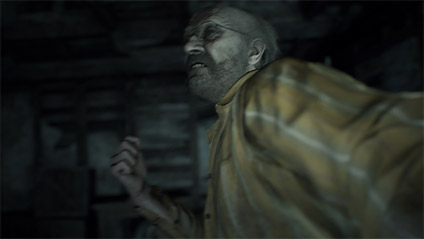
Jack many unpredictable movements and behaviors.
This allows players to feel a very extraordinary type of fear.
Nakanishi: Game development is like that as well. Making players feel that they do not know what lies ahead and that they cannot be careless is integral to survival horror. You feel the danger in your body, but in a situation in which the information you need to survive is insufficient, a sense of uncertainty is born and this leads to fear.
That’s a good point.
Also, in regards to this game, even though the system and UI are completely different, I can strongly sense the ”fear of corners” and ”fear of opening doors,” as well as fear of not seeing things on the screen. Why do you think this is?

You might think of the doors when you hear “Resident Evil,” but in this game, it’s scary to just open the doors!
Just where does this sense of fear come from?
Nakanishi: It’s due to ”being anchored.” I don’t know if this is an everyday word or not, but that’s what I call it.
We give players ample opportunities to experience the feelings of “turning a corner and having something terrible happen” and “something sneak attacking you as you open a door.” So when players “turn corners” or “open doors” they will, whether they realize it or not, recall their experiences with fear. They may say things like, “Ugh, yikes” and “Is there something else here?”
On the other hand, if the scary points are just chaotically placed into the game, then players will end up being nervous for the entire game, which can be tiring. We’ve tried to put in moments when it is easy to know that “something might happen.”
Even if the player knows something might happen, he/she has no choice but to move forward. These moments are what I think are the true pleasure of horror games.
I see! During the the game, there are boxes that explode when broken with the Knife, making you too scared to break them open.
Nakanishi: Yeah, that’s right. (laughs) I think that’s a special case. This serves to keep players on their toes with new elements ― they get used to the game’s crate boxes being safe to open, and then the game turns around and surprises them by changing things around in the second half. We thought about how the doors, corners and other things would be done in the game from the beginning.
Anpo: Indeed, the beginning is important. You have to plant those elements into the gameplay experience early on.
Nakanishi: This part is truly difficult, but this will change depending on the player’s degree of perception.
In other words, people who detect “an atmosphere where something might happen” and people who have no clue that something will happen.
People who know too well will become desensitized. Rather, it invites carelessness and getting caught off guard, forcing these players to realize and admit that “These boxes can explode too?!”
Those who have a low degree of horror perception are in a better position to experience the game.
Horror games have to bargain with their users as well.
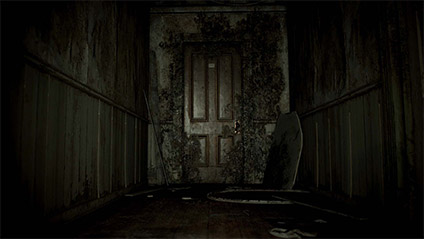
From this spot, one can see how ominous this door appears.
The idea of “being anchored“ allows players to experience fear simply by opening a door.
ESSENCES AND VARIATIONS OF FEAR
Nakanishi: For “Resident Evil” there are times when the “the fear is short-lived.”
Mmm? What does that mean, exactly?
Nakanishi: Resident Evil has allowed players to defeat enemies, which are supposed to be manifestations of fear. It is fun to take those enemies down.
However, being able to take care of the enemies and be victorious over them is the complete opposite of the sense of something being “unknown.” That makes things less scary.
Therefore, we had a dilemma with the game’s structure: “we wanted players to experience fear, but if enemies cannot be defeated, then that would not be very fun either.”
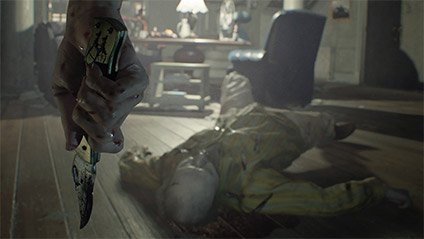
Resident Evil, where one is destined to fight in order to overcome the situation.
However, just when you think you’ve “won”…?
I see. What did you do to address that issue?
Nakanishi: For RE7, we ended up changing around the “essence” of fear.
…”Essence”?
Nakanishi: For example, the father (Jack) is an slasher-type enemy who exhibits straightforward violence, while the mother (Marguerite) is a hellish insect-type enemy who is laying who makes players feel disgusted, while the Son (Lucas) is a trapper-type enemy who messes with the protagonist psychologically, similar to the movie “Saw.” By separating enemies into certain types, we were able to prolong the sense of fears felt by players.
This is what the Baker family concept was based on.
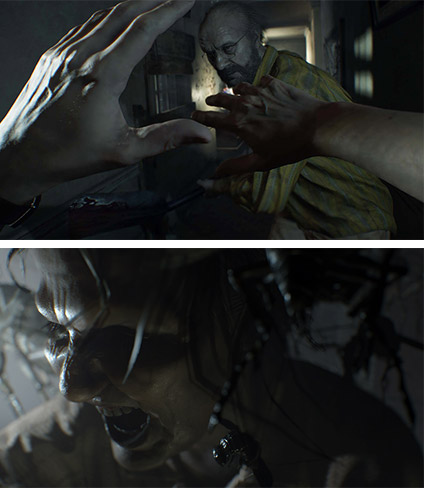
Each member of the Baker family were given different types of fear elements.
The players would encounter these different kinds of fear each time an enemy was confronted.
I see! Different types of fear alter the essence of that fear. This allows the player’ experiences of fear to change as well.
Nakanishi: Actually, during the early planning stages we used the phrase “shrieking haunted house” as keywords, but that wa the idea. That is what would allow us to scare many people while allowing them to enjoy the game.
This time, we felt that we did well in giving the Bakers different types of fear elements.
However, if there is a next time, it would be tough to reuse the same patterns again, so we have to think of a new and different approach. Horror games are scary until the enemies appear, and when they are able to defeat them, the game stops being scary. Figuring out how to overcome this problem is an important theme.
Anpo: In movies, I think that fighting back just once becomes the climax of the movie. (laughs)
Nakanishi: I’m jealous that a movie can be finished in 2 hours (laughs). Games are typically enjoyed for at least 10 hours or more.
Anpo: In that sense, I think “Resident Evil 7” has been quite successful. Changing the situations and weapons in the middle of the game means you won’t get tired of it.
When the situations change suddenly, you find yourself unable to use your weapons, which makes players feel desperate.
Nakanishi:In “Resident Evil Revelations,” there was a scene in which Jill is captured and then is seen waking up on a bed. There are fans who have told me that this was the scariest part of the game for them. Indeed, having all your weapons taken from you does instill a strong sense of anxiety.
Anpo: In the middle of RE7, there is a part where you have to deposit all of your weapons. You wonder if you’ll be able to get them back. You’re secretly able to retrieve your Knife. (laughs)
Yeah, yeah, I did that part!
Nakanishi: In games, being unable to use items you have acquired or being unable to utilize the theories you have learned can be very stressful for players and goes up against conventional game design theory.
I think horror games that use this style to make themselves interesting are a special genre.
CREATING AN UNSOLVABLE MYSTERY
Nakanishi: Early on in the game, there is a scene where someone’s hand is cut off. That was the idea of the Art Director and was not planned at the beginning.
When the game had progressed to a certain stage, the Art Director proposed, “if we don’t do something like have arms getting amputated, then the game’s impact will be weak.” So, I asked him “well, what would happen AFTER his arm gets cut off?” He said, ”Yeah, what should happen?” (laughs)
Also, Tsugumi Ooba of the original Death Note said something along the lines of “in terms of creating drama and coming up with the story, you must in still into your characters the feeling of desperateness and the pinch of a near-death situation. You must then think of a way to escape the situation.”
Indeed, this is what we end up doing because it has impact.
When we actually finished then game, many players would become confused when playing the game, and would utter remarks such as “Huh? What is that? Huh, really?! Is this right?” I think this was very effective — the feeling that “one cannot become careless in this game.”
Anpo: Normally, these are the situations that you can only see when you’re on the path to a Game Over. (laughs)
Nakanishi: The part where the arm is amputated was added during an experimental phase of development. But for Resident Evil 7, at that stage we had decided not to create a story because we “wanted players to experience the game itself” and that if we made a story, then the game would be pulled right into the story. In other words, the development of the story would become incoherent. Also, if the story were the main component of the game, then the gameplay and event scenes will become separated from it, so at the beginning of development, we created scary and interesting game situations.
Therefore, the mutation of certain characters and the amputation of the arm were placed into the game while creating these very situations.
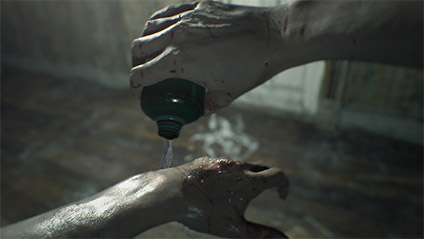
The player character restoring health.
However, aren’t those some pretty serious injuries…?!
I see. So the impact was more important here.
Nakanishi: Yes. These experimental elements were polished during the actual phase of development. At that point, there were also impactful scenes that were not put into the final game.
That’s too bad.
Nakanishi: Also, we created a lot of mysteries. Thinking about it now, this might be because of the lack of a story and the motivation for playing the game having to depend on the encounters with the enemies in the game and the mysterious items present in the game.
During development, there were so many mysteries that not all of them could be collected.
*laughs*
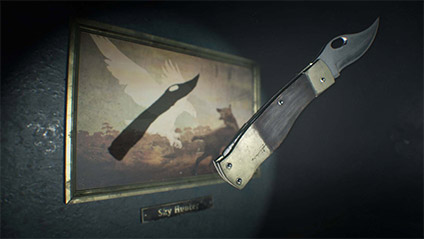
An image of the “Shadow Puzzles” in which the shadow of a bird is hovering on the wall.
They have said that there were more of these elements in the game at first.
Looking at internet reviews, many of them are saying that the game ”will shock you like the original Resident Evil did” even though the gameplay and screens are completely different. I was surprised that these impressions were frequent.
Nakanishi: As we’ve mentioned up until this point, RE7 is the result of us analyzing what made the original Resident Evil so scary and interesting and reconstructing it. The result is something completely different from recent games. There will be fans who might think “this is wrong,” but the we have been told from people, including those overseas, that “the king of Survival Horror is back!” We are grateful for these comments.
Alright, we’ll end this session right here.
In the next session, which will be released on March 9, we will take a look at Resident Evil 7 and explore secrets of its production “as a Resident Evil game”.
Look forward to it!
(Interviews: Kita-san, Ucchii)

PROFILES
Yasuhiro Anpo
Joined Capcom in 1994. Programmer for Resident Evil and Resident Evil 2. Worked on Onimusha, Onimusha 3 and Shadow of Rome. Returned to the Resident Evil series as Director for Resident Evil 5. Planner for Resident Evil Revelations, Director for Resident Evil Revelations 2 and EX Troopers.
Koshi Nakanishi
Joined Capcom in 2007. Game Designer for Resident Evil. Director for Resident Evil Revelations and Resident Evil 7.

